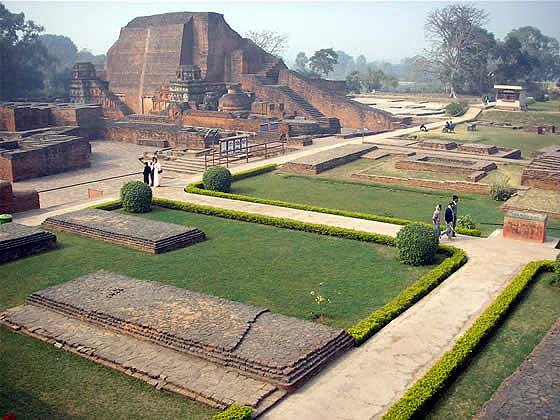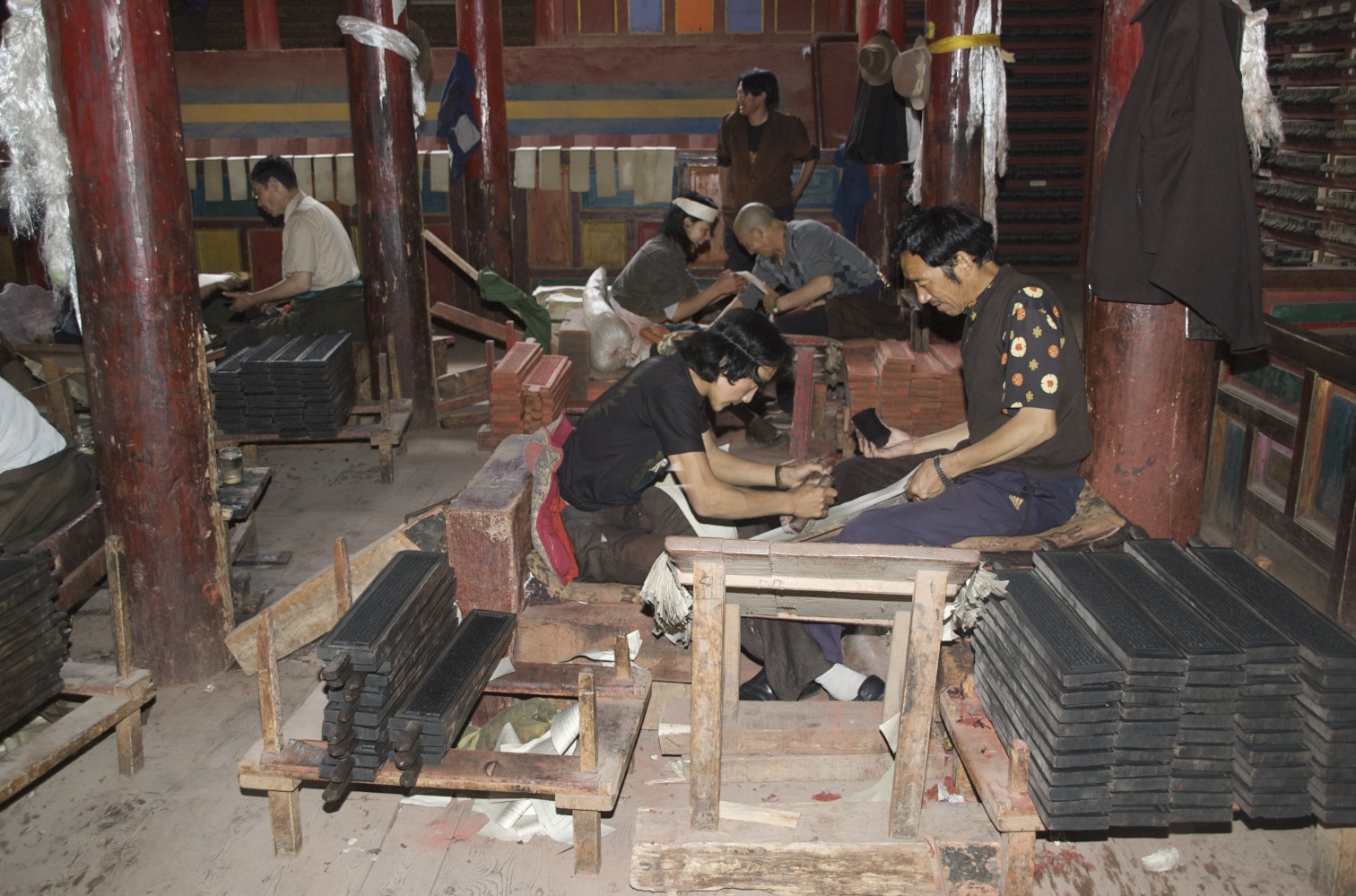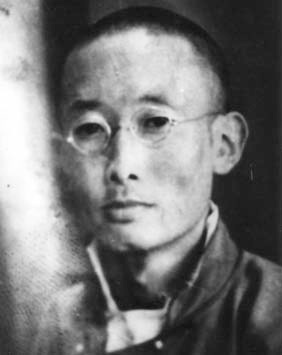|
Jamgön Ju Mipham Gyatso
Jamgön Ju Mipham Gyatso, or Mipham Jamyang Namgyal Gyamtso (1846–1912) (also known as "Mipham the Great") was a very influential philosopher and polymath of the Nyingma school of Tibetan Buddhism. He wrote over 32 volumes on topics such as painting, poetics, sculpture, alchemy, medicine, logic, philosophy and tantra. Mipham's works are still central to the scholastic curriculum in Nyingma monasteries today. Mipham is also considered to be one of the leading figures in the Rimé (non-sectarian) movement in Tibet. Derivation of name "Ju" ("holding") was Mipham's family name as his paternal clan is said to have originated as clear light deities who came to the human world holding a rope. "Jamgön" (Skt. Mañjunātha) indicate that he was considered to be an emanation of the bodhisattva Mañjuśrī. His maternal uncle, Minister-Lama Drupchok Pema Tarjay, named him Mipham Gyamtso ("Invincible Ocean" or "Unconquerable Ocean"). In Tibetan literature, the word "mi-pham" is the stan ... [...More Info...] [...Related Items...] OR: [Wikipedia] [Google] [Baidu] |
Buddhist Philosophy
Buddhist philosophy is the ancient Indian Indian philosophy, philosophical system that developed within the religio-philosophical tradition of Buddhism. It comprises all the Philosophy, philosophical investigations and Buddhist logico-epistemology, systems of rational inquiry that developed among various schools of Buddhism in ancient India following the ''Parinirvana, parinirvāṇa'' of Gautama Buddha (c. 5th century BCE), as well as the further developments which followed the Silk Road transmission of Buddhism, spread of Buddhism throughout Asia. Buddhism combines both philosophical reasoning and the Buddhist meditation, practice of meditation.Siderits, Mark. Buddhism as philosophy, 2007, p. 6 The Buddhist religion presents a multitude of Buddhist paths to liberation; with the expansion of early Buddhism from ancient India to Sri Lanka and subsequently to East Asia and Southeast Asia, Buddhist thinkers have covered topics as varied as cosmology, ethics, epistemology, logic ... [...More Info...] [...Related Items...] OR: [Wikipedia] [Google] [Baidu] |
Jamyang Khyentse Wangpo
Jamyang Khyentse Wangpo (, 1820–1892), also known by his tertön title, Pema Ösel Dongak Lingpa, was a teacher, scholar and tertön of 19th-century Tibet. He was a leading figure in the Rimé movement. Having seen how the Gelug institutions pushed the other traditions into the corners of Tibet's cultural life, Jamyang Khyentse Wangpo and Jamgön Kongtrül Lodrö Thayé compiled together the teachings of the Sakya, Kagyu and Nyingma, including many near-extinct teachings, thus creating the Rimé movement. Without their collection and printing of rare works, the suppression of Buddhism by the Communists would have been much more final. Biography Jamyang Khyentse Wangpo was born in 1820 on the 5th day of the 6th month of the Iron Dragon year of the 14th Rabjung, in the region of Yaru Khyungchen Drak in The Valley of Taerlung( treasure/spiritual)in Derge to a family named Dilgo of Dilgo village, Kham. His father was Rinchen Namgyal, the secretary of the king of Derge belonging ... [...More Info...] [...Related Items...] OR: [Wikipedia] [Google] [Baidu] |
Monk
A monk (; from , ''monachos'', "single, solitary" via Latin ) is a man who is a member of a religious order and lives in a monastery. A monk usually lives his life in prayer and contemplation. The concept is ancient and can be seen in many religions and in philosophy across numerous cultures. The Greek word for "monk" may be applied to men or women. In English, however, "monk" is applied mainly to men, while ''nun'' is typically used for female monastics. Although the term ''monachos'' is of Christianity, Christian origin, in the English language ''monk'' tends to be used loosely also for both male and female ascetics from other religious or philosophical backgrounds. However, being generic, it is not interchangeable with terms that denote particular kinds of monk, such as cenobite, hermit, anchorite, or Hesychasm, hesychast. Traditions of Christian monasticism exist in major Christian denominations, with religious orders being present in Catholicism, Lutheranism, Oriental Ort ... [...More Info...] [...Related Items...] OR: [Wikipedia] [Google] [Baidu] |
Monastery
A monastery is a building or complex of buildings comprising the domestic quarters and workplaces of Monasticism, monastics, monks or nuns, whether living in Cenobitic monasticism, communities or alone (hermits). A monastery generally includes a place reserved for prayer which may be a chapel, Church (building), church, or temple, and may also serve as an Oratory (worship), oratory, or in the case of Cenobium, communities anything from a single building housing only one senior and two or three junior monks or nuns, to vast complexes and estates housing tens or hundreds. A monastery complex typically comprises a number of buildings which include a church, dormitory, cloister, refectory, library, Wiktionary:balneary, balneary and Hospital, infirmary and outlying Monastic grange, granges. Depending on the location, the monastic order and the occupation of its inhabitants, the complex may also include a wide range of buildings that facilitate self-sufficiency and service to the commun ... [...More Info...] [...Related Items...] OR: [Wikipedia] [Google] [Baidu] |
Kham
Kham (; ) is one of the three traditional Tibet, Tibetan regions, the others being Domey also known as Amdo in the northeast, and Ü-Tsang in central Tibet. The official name of this Tibetan region/province is Dotoe (). The original residents of Kham are called Khampas (), and were governed locally by chieftains and monasteries. Kham covers a land area distributed in multiple province-level administrative divisions in present-day China, most of it in Tibet Autonomous Region and Sichuan, with smaller portions located within Qinghai and Yunnan. Densely forested with grass plains, its convergence of six valleys and four rivers supported independent Kham polities of Tibetan warrior kingdoms together with Tibetan Buddhist monastic centers.Jann Ronis"An Overview of Kham (Eastern Tibet) Historical Polities" The University of Virginia The early trading route between Central Tibet and China traveled through Kham, and Kham is said to be the inspiration for Shangri-La in James Hilton's nove ... [...More Info...] [...Related Items...] OR: [Wikipedia] [Google] [Baidu] |
Derge
Derge (), officially Gengqing Town (; ), is a town in Dêgê County in Garzê Tibetan Autonomous Prefecture in Sichuan, China. It was once the center of the Kingdom of Derge in Kham. History Historically, Derge, which means "land of mercy", was an important centre of Tibetan culture, along with places such as Lhasa and Xiahe. Derge was formerly the seat of the kings of the kingdom of Derge, whose 1300-year lineage was broken with the death of the last male heir in the 1990s. The kingdom was an important industrial, religious and political center in Eastern Tibet. In the early 20th century, the kingdom fell into political struggle between the final heirs to the throne, Djembel Rinch'en and Doje Senkel. The latter, who had enjoyed the backing of the Chinese, yielded the kingdom to China in 1908 in exchange for the ousting of his rival. The palace of the Derge kings was torn down after 1950 and a school was later built on the site.McCue, 241. Culture The town of Derge is famous fo ... [...More Info...] [...Related Items...] OR: [Wikipedia] [Google] [Baidu] |
Tibet
Tibet (; ''Böd''; ), or Greater Tibet, is a region in the western part of East Asia, covering much of the Tibetan Plateau and spanning about . It is the homeland of the Tibetan people. Also resident on the plateau are other ethnic groups such as Mongols, Monpa people, Monpa, Tamang people, Tamang, Qiang people, Qiang, Sherpa people, Sherpa, Lhoba people, Lhoba, and since the 20th century Han Chinese and Hui people, Hui. Tibet is the highest region on Earth, with an average elevation of . Located in the Himalayas, the highest elevation in Tibet is Mount Everest, Earth's highest mountain, rising above sea level. The Tibetan Empire emerged in the 7th century. At its height in the 9th century, the Tibetan Empire extended far beyond the Tibetan Plateau, from the Tarim Basin and Pamirs in the west, to Yunnan and Bengal in the southeast. It then divided into a variety of territories. The bulk of western and central Tibet (Ü-Tsang) was often at least nominally unified under a ser ... [...More Info...] [...Related Items...] OR: [Wikipedia] [Google] [Baidu] |
Rimé Movement
The Rimé movement (Tibetan Wylie: ''ris med''; approximate pronunciation "reemay") also written in some English sources as Rime, Ri-me, Rimay) is a movement or tendency in Tibetan Buddhism which promotes non-sectarianism and universalism.Sam van Schaik (2011). ''Tibet: A History'', pp. 161–162. Yale University Press. Teachers from all branches of Tibetan Buddhism – Sakya, Kagyu, Nyingma, Jonang, Gelug – and from Bon have been involved in the promoting of Rimé ideals.Lopez, Donald S. (1998). ''Prisoners of Shangri-La: Tibetan Buddhism and the West''. Chicago: University of Chicago Press, p. 190 According to Sam van Schaik, eclectic and non-sectarian tendencies existed in Tibetan Buddhism before the 19th century, and figures like Tsongkhapa, Longchenpa and Shabkar are widely known to have studied with teachers from different traditions. However, political divisions and religious sectarianism increased during a period of warfare in the sixteenth and seventeenth cen ... [...More Info...] [...Related Items...] OR: [Wikipedia] [Google] [Baidu] |
Tibetan Buddhism
Tibetan Buddhism is a form of Buddhism practiced in Tibet, Bhutan and Mongolia. It also has a sizable number of adherents in the areas surrounding the Himalayas, including the Indian regions of Ladakh, Gorkhaland Territorial Administration, Darjeeling, Sikkim, and Arunachal Pradesh, as well as in Nepal. Smaller groups of practitioners can be found in Central Asia, some regions of China such as Northeast China, Xinjiang, Inner Mongolia and some regions of Russia, such as Tuva, Buryatia, and Kalmykia. Tibetan Buddhism evolved as a form of Mahayana, Mahāyāna Buddhism stemming from the latest stages of Indian Buddhism (which included many Vajrayana, Vajrayāna elements). It thus preserves many Indian Buddhist Tantra, tantric practices of the Gupta Empire, post-Gupta Medieval India, early medieval period (500–1200 CE), along with numerous native Tibetan developments. In the pre-modern era, Tibetan Buddhism spread outside of Tibet primarily due to the influence of the Mongol Emp ... [...More Info...] [...Related Items...] OR: [Wikipedia] [Google] [Baidu] |
Thubten Chökyi Dorje
Thubten may refer to: *Thubten Chökyi Dorje, 5th Dzogchen Rinpoche (1872–1935), the 5th Dzogchen Rinpoche of Tibet in the Nyingma sect of Tibetan Buddhism *Thubten Chodron, an American Tibetan Buddhist nun and a central figure in reinstating the Bhikshuni *Thubten Choekyi Nyima, 9th Panchen Lama (1883–1937), the 9th Panchen Lama of Tibet *Thubten Gyatso (Australian monk), one of the first Westerners to become a monk in the Gelug school of Tibetan Buddhism *Thubten Gyatso (NKT), a 'Gen-la' and Resident Teacher of Madhyamaka Centre (Pocklington, York) *Thubten Jigme Norbu (1922–2008), a Tibetan lama, writer, civil rights activist and professor of Tibetan studies *Thubten Yeshe (1935–1984), a Tibetan lama who, while exiled in Nepal, co-founded Kopan Monastery *Thubten Zopa Rinpoche Thubten Zopa Rinpoche (; born Dawa Chötar, 3 December 1945 – 13 April 2023) was a Tibetan Buddhist lama in the Gelug school. He is known for founding the Foundation for the P ... [...More Info...] [...Related Items...] OR: [Wikipedia] [Google] [Baidu] |
Gendün Chöphel
Gendun Chompel or Gendün Chöphel () (1903–1951) was a Tibetan scholar, thinker, writer, poet, linguist, and artist. He was born in 1903 in Shompongshe, Rebkong, Amdo. He was a creative and controversial figure and is considered by many to have been one of the most important Tibetan intellectuals of the twentieth century. Chöphel was a friend of the Indian scholar and independence activist Rahul Sankrityayan. His life was the inspiration for Luc Schaedler's film ''The Angry Monk: Reflections on Tibet''. He is best known for his collection of essays called ''The Madman's Middle Way: Reflections on Reality of the Tibetan Monk Gendun Chophel''. and ''Grains of Gold: Tales of a Cosmopolitan Pilgrimage'', written during his time in India and Sri Lanka in between 1934 and 1946. These essays were critical of modern Hinduism, Christianity, and British imperialism. While condemning places and events like the Black Hole of Calcutta and the Goa Inquisition, he praised certain Britis ... [...More Info...] [...Related Items...] OR: [Wikipedia] [Google] [Baidu] |








